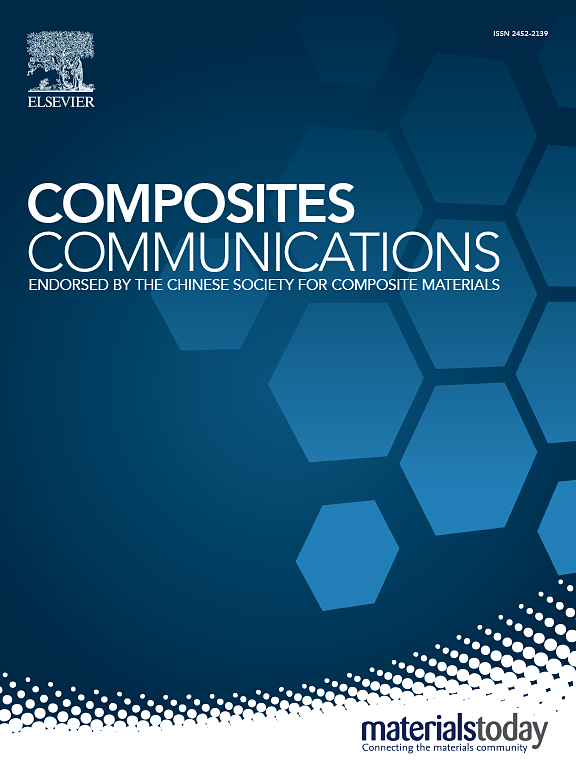增强双向导热性:用于先进热管理的新型三层石墨烯-液态金属复合材料
IF 6.5
2区 材料科学
Q1 MATERIALS SCIENCE, COMPOSITES
引用次数: 0
摘要
电子器件的快速发展要求开发高性能导热材料以实现高效的热管理。本研究提出了一种新型复合导热膜,具有独特的三明治结构,旨在克服热管理中的关键挑战。该复合材料是用石墨烯-碳纤维基体封装液态金属作为核心层,包裹在石墨烯膜之间。这种设计利用了石墨烯卓越的平面内导热性、机械稳定性和隔离性能;碳纤维的结构支撑和侧向密封;液态金属优越的导热性和空隙填充能力。制备的薄膜具有优异的热性能,其面内导热系数为106.1 W/mK,透面导热系数为43.1 W/mK。夹层结构有效抑制高压条件下液态金属的泄漏和腐蚀,同时保持坚固的机械完整性。与常见的热界面材料不同,这种三层结构具有独特的热管理功能。底层是石墨烯薄膜,作为热传导层,将点传导转化为更快的表面传导。中间层为柔性垂直导热层,起到传热的高速公路作用。由于石墨烯优异的辐射特性,顶层有效地散热。因此,该复合材料不仅可以用作热界面材料,还可以用作小型移动电子设备中的散热材料。本文章由计算机程序翻译,如有差异,请以英文原文为准。

Enhancing Bi-directional thermal conductivity: A novel tri-layer graphene-liquid metal composite for advanced thermal management
The rapid advancement of electronic devices demands the development of high-performance thermal conductive materials for efficient thermal management. This study presents a novel composite thermal conductive film featuring a unique sandwich structure designed to overcome critical challenges in thermal management. The composite is constructed using a graphene-carbon fiber matrix encapsulating liquid metal as the core layer, enclosed between graphene membranes. This design harnesses graphene's exceptional in-plane thermal conductivity, mechanical stability, and isolation properties; carbon fiber's structural support and lateral sealing; and liquid metal's superior thermal conductivity and gap-filling capabilities. The resulting film achieves outstanding thermal performance, with an in-plane thermal conductivity of 106.1 W/mK and a through-plane thermal conductivity of 43.1 W/mK. The sandwich structure effectively suppresses liquid metal leakage and corrosion under high-pressure conditions, while retaining robust mechanical integrity. Unlike common thermal interface materials, this three-layer structure performs distinct thermal management functions. The bottom layer, a graphene film, acts as a heat-spreading layer, transforming point conduction into faster surface conduction. The middle layer is a flexible vertical heat conduction layer, serving as a highway for heat transfer. The top layer efficiently dissipates heat due to graphene's excellent radiative properties. This composite material can thus be used not only as a thermal interface material but also as a heat dissipation material in small mobile electronic devices.
求助全文
通过发布文献求助,成功后即可免费获取论文全文。
去求助
来源期刊

Composites Communications
Materials Science-Ceramics and Composites
CiteScore
12.10
自引率
10.00%
发文量
340
审稿时长
36 days
期刊介绍:
Composites Communications (Compos. Commun.) is a peer-reviewed journal publishing short communications and letters on the latest advances in composites science and technology. With a rapid review and publication process, its goal is to disseminate new knowledge promptly within the composites community. The journal welcomes manuscripts presenting creative concepts and new findings in design, state-of-the-art approaches in processing, synthesis, characterization, and mechanics modeling. In addition to traditional fiber-/particulate-reinforced engineering composites, it encourages submissions on composites with exceptional physical, mechanical, and fracture properties, as well as those with unique functions and significant application potential. This includes biomimetic and bio-inspired composites for biomedical applications, functional nano-composites for thermal management and energy applications, and composites designed for extreme service environments.
 求助内容:
求助内容: 应助结果提醒方式:
应助结果提醒方式:


